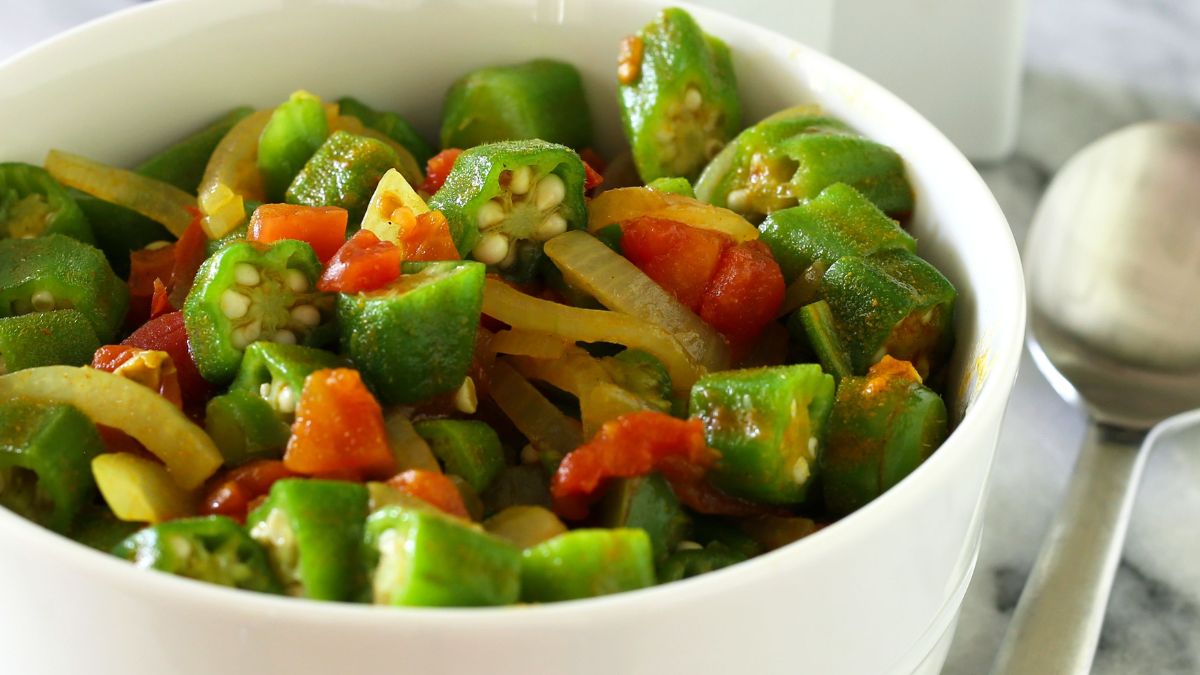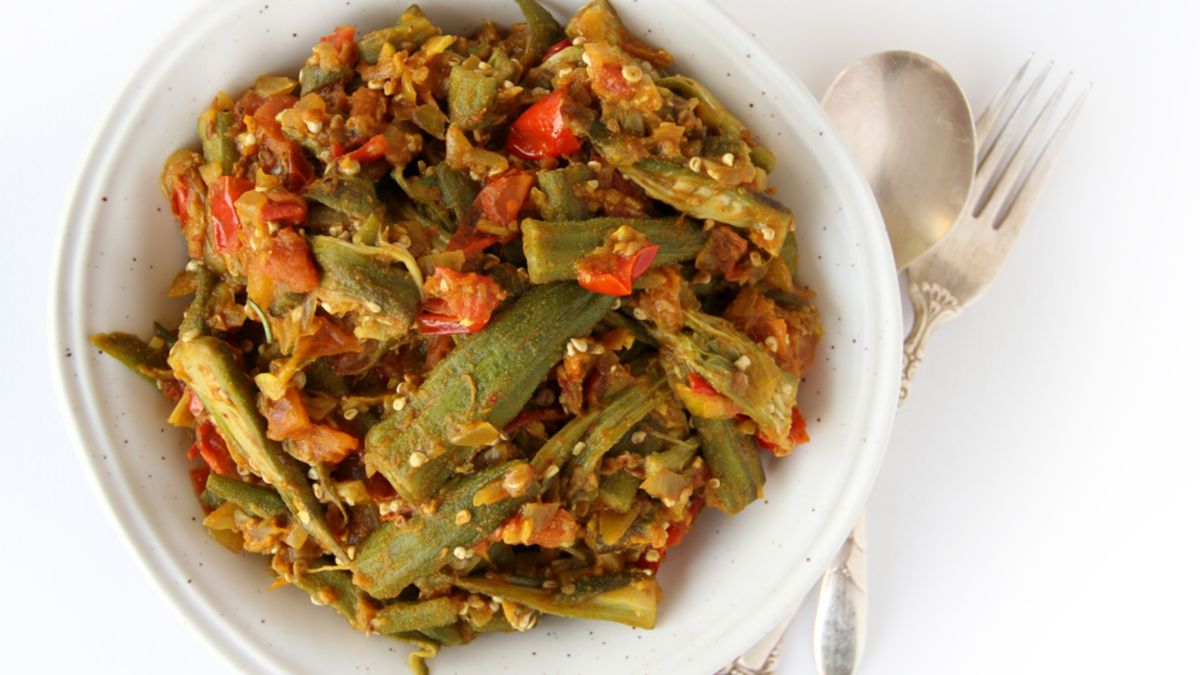The seed pod of the Abelmoschus esculentus plant is known as okra. It has a long, slender, tubelike structure packed with small white seeds. It is also known as lady’s fingers. Okra is a plant that originated in Ethiopia and was transported to North America by settlers and enslaved people centuries ago. It thrives in warm, muggy areas. India, Nigeria, Sudan, Pakistan, Ghana, Egypt, Benin, Saudi Arabia, Mexico, and Cameroon are some of the top producers; it is also produced in Florida and other southeastern states.
Okra is one of those foods that people either love or detest, yet it is a staple in Southern, Caribbean, and Indian cuisines, especially in gumbo and stews. There’s no denying that okra is one of those vegetables with varied connotations for different people. Okra’s tendency to become slimy and smooth when cooked is typically blamed by those who don’t like it, but others prefer it for this reason.
What is Okra?
Although it is consumed as a vegetable, okra is a fruit. The light green seed pods can be prepared in various ways and are very simple to prepare, either whole or cut. It can, however, be reduced or avoided from turning slimy by using the proper cooking technique, such as frying, grilling, sautéing, and pan-roasting. Fresh okra is frequently sold by the pound in American grocery shops during the summer when it is in season. When imported, it costs more throughout the winter.
Although we may think of this plant as a vegetable when preparing food, it is a fruit because it contains seeds. These undeveloped seed pods of the okra plant, Abelmoschus esculentus, are what give these fuzzy green vegetables their color. Depending on where you live, they are also known as “gumbo” and “lady’s fingers.” India is the world’s top producer of okra, and hot, humid regions are the greatest for growing it.
Okra’s slimy texture can divide people. Of course, it contains mucilage, a naturally occurring ingredient that thickens stews and gumbos. While some find this offensive, others think its distinctive texture makes it ideal for roasting or frying. Dry heat and quick roasting can reduce the sliminess. Additionally, it has a moderate, slightly grassy flavor and an outer fuzz that resembles a peach. Okra is frequently prepared by boiling, frying, roasting, canning, or boiling.
Curried Okra with Onions Recipe
Vegetable okra is well-liked all around the world. Okra’s origin is unknown. However, many people think it came from Africa or South Asia. Okra is a key ingredient in Southern cuisine. In the first half of the 1700s, it was presumably imported to America from Africa. It was a typical vegetable in the Southern United States by 1800.
The texture might be unappealing when okra is cooked in various ways, especially if the meal involves liquids. The distinctive “slimy” material helps to thicken gumbos and other soups. The sliminess can be lessened in a few different ways. Acidic ingredients can help to ease the unpleasant texture. You may cook the okra with complementing tomatoes or add a little lemon juice, tamarind, or vinegar to it. Alternately, try soaking it in a vinegar and water mixture, which many chefs swear by. Add 1/4 cup of white vinegar or apple cider vinegar for every cup of water.
Okra’s goo reacts with liquids. Therefore, it’s crucial to completely dry the pods and boil them rapidly (to avoid steam). Okra that has been roasted or fried is frequently less slimy. This okra dish is a tasty vegetarian dish served over hot boiled rice or served with Southern fried chicken, pork chops, or steaks.
Ingredients
- 1 pound okra
- Two tablespoons of vegetable oil
- One tomato or about 1 cup diced canned tomatoes
- One large onion
- One dash of cayenne pepper, or more to taste
- 1/4 teaspoon ground turmeric
- 1/4 teaspoon curry powder, or to taste
- Kosher salt, to taste
- Freshly ground black pepper, to taste
Steps to Make it
- Gather the ingredients.
- The okra pods should be well washed and dried. Cut off and throw away the okra pods’ tips and stem ends. Okra should be cut into 1/2-inch rounds.
- Over medium-high heat, warm the oil in a sizable, heavy nonstick, or well-seasoned iron skillet. Sliced okra should be added to the hot, shimmering oil and stir-fried for 10 minutes, flipping and often stirring to prevent sticking.
- While waiting, core, seed, and dice the tomato. Peel the onion, then finely slice the sections. Place aside.
- Add the diced tomato, thinly sliced onion, cayenne pepper, turmeric, and curry powder when the okra starts to brown.
- Cook the onions for an additional 3 minutes, or until they are soft.
- Taste and add kosher salt and freshly ground black pepper, as needed.
Additional Tip
When selecting fresh okra, okra that has been freshly trimmed produces about 4 cups of slices per pound. Ook for vivid green pods no longer than 4 inches. They ought to be solid and damage- and imperfection-free.
Recipe Variations
Basil, corn, coriander, cumin, curry powder, garlic, lemon, onions, parsley, sweet bell peppers, tomatoes, and tomato sauces are complimentary seasonings and ingredients if you enjoy experimenting with flavors in your cooking.
What does it Taste Like?
Okra has a distinctive flavor that is light and somewhat grassy. Even though its flavor is occasionally compared to green beans or eggplant, people tend to focus on its texture. When cooked rapidly, okra retains its crunch, but it practically melts in your mouth tenderness when cooked slowly.
Okra Recipes
Gumbo and fried okra should surely be on your recipe list as you learn how to prepare okra. After that, you’ll relish experimenting with okra in several various meals, such as:
- Kurkuri Bhindi: Indian Crispy Okra
- Southern Style Pimento Cheeseburger
Where to Buy Okra?
Okra, that is still young should feel solid but not hard. Look for pods that are brilliant green and have smooth skin. While a little browning on the stem shouldn’t be a problem, the fresher the okra is, the more green the stem should be. It’s not a very well-known fruit, and not all supermarkets carry it in a new form. It is offered precut and frozen in 12- to 16-ounce bags at many supermarket stores. May through September, when it is in season, offer the highest possibilities of locating it.
Okra is an annual that resists drought and does best in warm, muggy climates. 1 After a gorgeous hibiscus-like bloom develops in shades of white, yellow, pink, or red; it will yield tasty seed pods. It’s a good idea to sow seeds (or indoor-grown starting plants) in rich, organic soil in full sun when the temperature reaches 80 degrees or above.
How to Store Okra?
Okra pods should be stored carefully because they can bruise rather quickly. Fresh okra should be wrapped in a paper towel, placed in a loose paper bag, and kept in the refrigerator’s vegetable drawer. Please wait until you’re ready to cook it before washing it. When kept in the fridge, okra can keep up to four days. Okra can be canned or frozen for long-term storage.
Start by blanching the pods in boiling water before shocking them in an ice bath to freeze the okra. After that, you can freeze the pods whole by laying them on a baking sheet lined with parchment paper or cutting the pods before freezing. Once the okra is frozen, transfer it to a freezer bag and save for up to a year.
Okra can be kept in paper bags in the vegetable drawer of your refrigerator for up to four days. It can also be loosely wrapped with plastic. Please remove it from the fridge and let it come to room temperature before preparing it for cooking—the amount of moisture emitted while cooking will be lessened. Okra pods should be washed and stemmed before being blanched in boiling water for a brief period, doused in an ice water bath, chopped, and flash frozen before being placed in freezer bags. You might even fry or bake battered pods before freezing, as Southern cooks do. Okra can be frozen for up to a year by gardeners who have an excess of it (which is frequently the case because pods commonly mature all at once).
Varieties
Okra has many cultivars, including Clemson Spineless, Annie Oakley, Baby Bubba Hybrid, Cajun Delight, Louisiana Green Velvet, and others. The most prevalent kind of okra in the United States is green okra, which has plants that can reach heights of three to eight feet with pods that can be long or short, pointy or rounded. Purple okra is also possible; while choosing it at the market, it should appear just as fresh as the green kind.
Tips for Growing Okra
Okra is simple to raise on your own. You will need to have a sizable garden, though. Okra plants have a maximum height of six feet. Here are some suggestions to make your okra plants in your garden thrive:
- Okra seeds don’t grow well in chilly soil, so plant them as soon as your soil is warm, which should be in the late spring.
- Okra plants should be placed several feet apart to allow them to flourish.
- Plants should be thinned when they are about three inches tall, so they are spaced 12 to 18 inches apart.
- Warm-weather crops like okra do best in the broad sun.
- Okra plants need around an inch of water every week, but if you live in a dry area, you can need even more.
- I trimmed the lower leaves off the plant to increase output after the initial harvest.
Obstacles to digestion: Okra includes fructans, a form of carbohydrate. People who already have digestive issues may have diarrhea, gas, cramping, and bloating from fructans. Some people may have negative effects from eating too much okra. Kidney stones: Okra contains a lot of oxalates.


